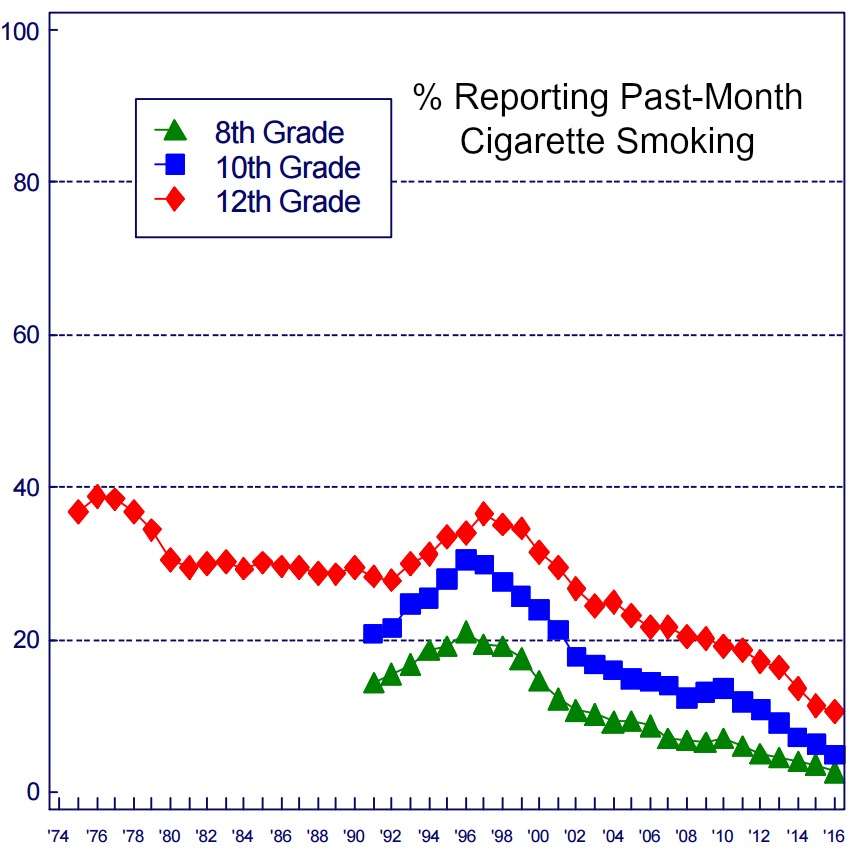Adolescent Smoking Falls Again, Confounding E-Cigarette Alarmists
The latest survey results deal another blow to the hypothesis that vaping leads to smoking.

New survey results deal yet another blow to the hypothesis that vaping leads to smoking, showing that conventional cigarettes are less popular than ever among teenagers despite the recent surge in adolescent experimentation with e-cigarettes. In the Monitoring the Future Study, the percentages of eighth-, 10th-, and 12th-graders who reported smoking cigarettes during the previous month fell again this year, continuing a downward trend that began in the late 1990s.
This survey began asking about e-cigarette use in 2014, and the share of teenagers who report vaping in the previous month has been falling since then. Among eighth-graders, past-month use fell from 8.7 percent in 2014 to 8 percent last year and 6.2 percent this year. Among 10th-graders, the rate was 16.2 percent in 2014, 14.2 percent this year, and 11 percent this year. Among 12th-graders, it fell from 17.1 percent in 2014 to 16.3 percent last year and 12.5 percent this year.
According to the National Youth Tobacco Survey, past-month vaping among high school students rose dramatically between 2011 and 2015—"an astounding 900 percent," as Surgeon General Vivek Murthy recently put it. The latter survey also shows a continuing decline in adolescent smoking, which last year hit a record low. Somehow that trend has not put a damper on warnings from alarmists like Murthy that e-cigarettes might be a gateway to the real thing.
Even Richard Miech, a Monitoring the Future researcher who recently pointed out that most adolescent vapers do not vape nicotine, seems unable to shake this unsupported fear. "Vaping may lead to friendship networks that encourage vapers to smoke," he says in a press release. "Also, vapers may come to believe the dangers of smoking are exaggerated if they do not experience any immediate health consequences from vaping." Maybe, but so far there is very little evidence that anything like that is happening.
"Whether adolescent vaping has peaked or only paused is something we will be able to determine in the coming years," Miech says. "In the past, we have seen new drugs follow a pattern in which use increases at a fast pace during a honeymoon period and then reverses course and declines as knowledge of the substance's drawbacks became known." If vaping by teenagers is waning, maybe the panic about it, which for too long has overshadowed the tremendous harm-reducing potential of e-cigarettes for people who otherwise would be smoking, will finally abate.
"At this point," writes Boston University public health professor Michael Siegel, "it is clear that whatever the risks of youth vaping may be, one of them is not the risk of progressing to smoking. If this hypothesis were true, we would simply not be seeing the historic declines in youth smoking that are occurring. Quite clearly, smoking continues to be de-normalized, not re-normalized as anti-tobacco groups and many health agencies have claimed. It appears that a culture of vaping is largely replacing a culture of smoking. If anything, it appears that the advent of e-cigarettes has accelerated the de-normalization of smoking by largely replacing it….Vaping appears not to be making smoking more cool, as claimed by the Surgeon General, the CDC, and anti-tobacco groups, but to be making smoking less cool. It also appears that there has been a plateau and now a decline in the rising fad of youth vaping, which should help ease the concerns of anti-tobacco groups that an entire generation of kids is going to be addicted to nicotine."
Note: This post, which originally said Monitoring the Future first asked about e-cigarette use in 2015, has been corrected and updated with survey numbers from 2014, which were omitted from this year's MTF report.


Show Comments (32)